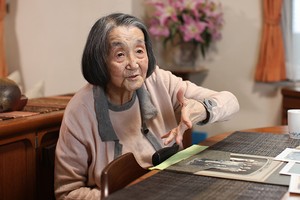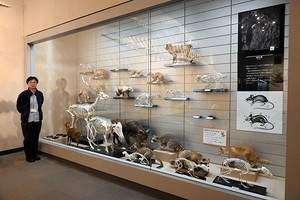By RYUICHIRO FUKUOKA/ Staff Writer
April 9, 2025 at 07:00 JST
NISHINOMIYA, Hyogo Prefecture--In his fairly short time with a couple here, Kotaro, an aging and ailing tomcat, showed impudence but also affection for his owners. It was a fairly uneventful period.
However, after his death, Kotaro became a corporate savior and the stuff of legends in the local rakugo storytelling world.
Kotaro’s story began at a cat cafe operated by a feline rescue group in Osaka. At that time, the cat was called Bunta because the look on his face evoked images of actor Bunta Sugawara (1933-2014).
Bunta was more than 10 years old and had kidney problems. The cafe’s workers were ready to give up hope of finding someone who would adopt him.
One day, Bunta was sitting alone at the entrance when Kojiro Okayama and his wife, Tomoe, visited the cafe. He purred and rubbed his head against the couple when they extended their hands to him. The cat refused to leave their side.
Both Kojiro, 47, and Tomoe, 50, were dog lovers, but Tomoe said: “Why don’t we take him home?”
The couple renamed the cat Kotaro after a character in a favorite anime work.
The Okayamas were told that the cat had been beaten with a stick when he was a stray. But Kotaro was very friendly toward humans and would climb readily on their laps.
Kotaro’s kidney disease progressed, and he died quietly in November 2015, 10 months after the Okayamas adopted him.
Kojiro, who returned home in time for the cat’s last moments, was in trouble himself. He even thought about joining Kotaro in death.
Kojiro is the second-generation owner of an Osaka-based manufacturer of “hanko” carved seals with around 20 workers.
As price competition intensified, he invested heavily in ads in hopes of turning things around.
But the effort was in vain, and his company posted more than 10 million yen ($67,000) in monthly deficits.
Kojiro came up with the idea of making Kotaro-themed hanko to conclude his business, which he thought “was going to fail at any rate.”
He released a hanko product featuring the drawing of a little cat to go with the carved name.
Only four units were sold in the initial week.
Later, however, a cat lover spread word of the product on social media, and 8,000 hanko were sold during a one-month period.
The joy was fleeting. A major discount dealer copied the idea.
Kojiro’s company expanded its series to include dog- and rabbit-themed hanko, but these ideas were again copied by other businesses.
Kojiro realized he had to come up with something different to thwart the copycats.
‘NOTHING TO LOSE’
A museum dedicated to famed manga artist Osamu Tezuka (1928-1989) is located near the Okayamas’ home in Nishinomiya, Hyogo Prefecture.
Prompted by the proximity, Kojiro contacted the company that administers Tezuka’s works and suggested a collaborative project.
“Doing so won’t do any harm,” he said he thought at the time. “I have nothing to lose.”
As it turned out, the company showed interest in Kojiro’s proposal.
In 2017, Kojiro’s company put on sale hanko products themed on Astro Boy (Mighty Atom) and Black Jack, both being Tezuka’s characters.
Decisions followed to commercialize additional hanko products themed on other popular works of Japanese pop culture--Pokemon, Hello Kitty, Case Closed (Detective Conan) and Jujutsu Kaisen.
The character-themed products proved popular among schoolteachers, who have opportunities to use hanko, and anime fans.
Annual sales of Kojiro’s company rebounded to 300 million yen.
But that is not the end of Kotaro’s story.
On March 7, Tsukitei Tenshi, a cat-loving “rakugo” comic storyteller, performed an original story at the Tenma Tenjin Hanjo-tei rakugo theater in Osaka.
Kotaro, the couple’s deceased cat, is the main character in the story.
A rakugo storywriter, whom Kojiro got to know by chance, composed the script based on what had happened to the Okayamas in reality.
According to the rakugo story, exactly three years after Kotaro died, the couple encounter another rescued cat that looks exactly like the dead one.
They rejoice at what looks like a born-again Kotaro.
“He’s not so much a Kotaro look-alike as he is Kotaro himself,’” they say in the story. “OK, they were like images from the same seal. And that’s about it.”
The Japanese idiom, “Like images from the same seal,” is used to describe things that recur with perfect regularity, like clockwork.
The real-life Kojiro and Tomoe now live with five shelter cats.
Kojiro said that when he thought that there was no future for the hanko industry, Kotaro helped him realize there were still things he could do.
When asked what he thought about Kotaro being the main character of a rakugo story, Kojiro referred to a well-known Japanese folktale about a crane that returns a favor.
“This is exactly about a cat that returns a favor,” he said.




















A peek through the music industry’s curtain at the producers who harnessed social media to help their idols go global.
A series based on diplomatic documents declassified by Japan’s Foreign Ministry
Here is a collection of first-hand accounts by “hibakusha” atomic bomb survivors.
Cooking experts, chefs and others involved in the field of food introduce their special recipes intertwined with their paths in life.
A series about Japanese-Americans and their memories of World War II